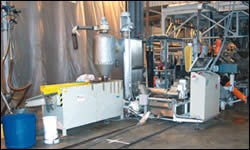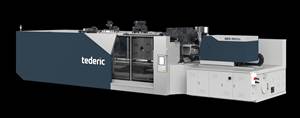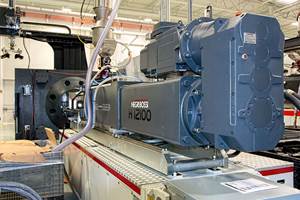Garbage In, Good Plastics Out
Experts consider it the most high-tech recycling plant in the world: Schwarzataler Kunststoff in Germany takes dirty bottles and film from post-consumer recycling and turns them into automotive and other compounds in a fully automated process.
Schwarzataler Kunststoff’s six-year-old plant, tucked away in the fairy-tale countryside of Eisfeld, Germany, is one of the world’s largest post-consumer recyclers. Every day it pr ocesses 250,000 lb of polyethylene film, 45,000 lb of PET bottles, and another 45,000 lb of HDPE bottles. An older plant in nearby Katzhuette compounds post-industrial scrap.
Schwarzataler is possibly the only integrated recycler in the world set up to take both flexible and rigid post-consumer plastics. Most large, technically advanced recycling operations handle either rigid or flexible plastics, but not both. What’s more, finished products from the Eisfeld plant include pelletized PE compounds in shades of gray and black that combine flexible and rigid PE in different ratios.
Schwarzataler starts with bales of presorted dirty bottles and film and upgrades them into automotive compounds and other products, including clean PET flake (clear and colored), clean HDPE flake, pelletized HDPE, and pelletized LL/LDPE.
Schwarzataler provides recycle-containing PE compounds for injection molded automotive parts. For example, some compounds are blended with PP for direct long-fiber compounding and molding of black parts for Volkswagen and Audi. A film company called SK Folie is building a plant next door to Schwarz ataler to use its recycled LDPE pellets. Other markets are furniture and pipe.
Birth of a leader
Schwarzataler’s technology and business plan are the work of its late founder, Manfred Leibold, who had worked in industrial scrap compounding for years and was known for his ability to make something out of nothing. In 1991 he bought an old fruit-packing plant in Katzhuette in former East Germany, keeping the original employees, even though they were agricultural workers without plastics processing skills. He converted both the plant and its workers to compounding plastic industrial scrap.
Leibold wanted to expand into post-consumer plastic compounding at Katzhuette, but its location between a mountain and a river didn’t have enough land for expansion. So in 1997 he built a new 430,000-sq-ft plant in Eisfeld to sort, grind, wash, and compound high volumes of post-consumer plastic. Four years later, after celebrating the company’s 10th anniversary, Leibold died of a heart attack.
Helmar Scheuring, a businessman, bought the company and has continued to expand its operation and invest in engineering. Output last year doubled as a result of improved efficiency, says assistant Sasha Beker.
Improvements range from office and managerial efficiencies to better machine uptime and faster-moving conveyor belts. Those belts run at about 2.8 meters per minute. Both the Katzhuette plant with 60 employees and Eisfeld with 150 employees run 24/7, stopping only for Christmas and Easter.
The Eisfeld plant is one of the 75 plastic recyclers that take plastic packaging from the German Green Dot program managed by Duales System Deutschland. Heinz Schnettler, technical manager at DSD in Cologne, says Eisfeld is the most technologically advanced of the bunch.
Twenty-five-ton trucks pull up to the plant around the clock, unloading every half hour to an hour. Schwarzataler takes presorted film and bottles in bales or large sacks. Both come primarily from the DSD’s “Yellow Bag” material. The DSD collects around 1.3 billion lb/yr of mixed plastic packaging in Yellow Bags, including rigid bottles, stretch film, meat wrap, bags, yogurt and margarine cups, polystyrene foam, self-service trays, and bubble wrap.
Schwarzataler then sorts bottles again, removing 20% to 25% by weight as waste. This fraction includes everything from rocks and metal to PVC bottles, PS, and paper. “Everything that can be recycled is,” Schwarzataler’s Beker notes. Aluminum and other metals are delivered to a local scrap-metal dealer. Other resins—PS, PVC, and PP—are baled and sold to other recyclers.
Each section of the plant is cleaned once daily on a fixed schedule. Equipment is hosed and blown out; floors are swept and scraped. At 11:00 each morning, for example, the up-front sortation area shuts down for an hour and is thoroughly cleaned. The floor in the truck docking bay is scraped daily to remove stickiness where incoming bales are unloaded. Unlike most post-consumer recycling plants, this one doesn’t smell.
Nine degrees of separation
Schwarzataler’s automatic separation is similar in concept to the DSD’s model plant in Hannover, where mixed plastic packaging is automatically separated into seven resin fractions. The Hannover plant uses mechanical separation devices on a grid of moving conveyors with automatic resin-identification stations. The Schwarzataler plant, which sorts only bottles, has made this layout much more compact.
Incoming bales of sorted bottles are broken open and go first into a large trommel, or revolving perforated metal cylinder, 2.5 meters in diam. x 10 meters long, which sorts the bottles through holes graduated in size from 50 mm at the beginning to 200 mm at the end.
Further separation is performed automatically by means of resin and color identification devices from TiTech Visionsort in Oslo, Norway. The first four of eight bottle-separation stations at Schwarzataler use the TiTech Polysort A 2000 device to identify resins by near-infrared (NIR) spectroscopy. The first station removes HDPE bottles from all the other bottles. The second station removes PVC bottles, the third PETG, and the fourth PP.
The fifth, sixth and seventh stations separate clear from colored PET bottles using the TiTech ColorSort R 1400 camera-based vision system. The eighth station takes off everything that isn’t identified by one of the earlier stations—primarily PS, EPS, and paper.
At each sorting station the designated material is blown with a row of air nozzles into a large bin roughly the size of a truck container. When a bin is full, the back opens automatically and a conveyor belt in the floor moves material out the back onto a second belt running perpendicularly behind all eight bins and leading to a baler. Only one bin unloads at a time. Separated PET bottles are perforated and compressed before being baled.
Baled bottles are then weighed, bar coded, and stored until needed for the next step. There are two parallel and identical recycling lines, one for PET and the other for HDPE. Each starts with a shredder supplied by STF Machine Anlagenbau GmbH. Shredded bottles then go to a float/sink tank for separation by density and washing (also built by STF). Clean PET flake is dried and sent to a dedicated silo.
HDPE bottles go through the same sequence of shredding, float/sink separation, washing, and drying. Clean HDPE flake is siloed, some to be used internally, some to be sold.
Dry & wet film cleaning
The film recycling section of the plant handles much higher volume and is set up with extensive redundancy so that it can keep running in case of any breakdown. The process starts with feeding up to four bales at a time by forklift to three large shredders from Vecoplan Maschinenfabrik GmbH. The shredding area is walled off from the rest of the plant for sound protection.
Each shredder feeds material onto two conveyor belts, for a total of six belts. Shredded film on the conveyors passes magnets that remove ferrous metal. Then comes a Vecoplan air classifier that removes heavy objects like wood, stone, and nonferrous metal, while air flow moves the lighter film forward.
Next, the film is blown hard against a screen, which knocks off any loose dust and loosens attached contaminants like labels. Shredded film then falls into three big holding bins, from which it is conveyed pneumatically to one of six Systec dry cleaning units developed by the DSD’s Sortec division.
This mechanical purifier removes most of the paper labels. Schwarzataler uses the Systec model MR 110 continuous centrifuge, which is 2.6 meters long and is designed to remove high levels of paper contamination. The device is a horizontal cylinder housing a central rotor with paddles turning at high speed inside a basket. Paper particles pass out through holes in the basket and are removed in an air stream.
After these four dry cleaning steps, shredded film goes into one of three wet washers from STF. After washing, flake goes into one of two large float/sink tanks, where a minor fraction of PVC film, which is heavier, is removed.
Wet flake then goes into one of six screw presses from Kufferath GmbH. They squeeze the water out mechanically to yield a final moisture content of 7.5% to 10%. Flake is finally dried in six agglomerators from Ermafa Kunst stofftechnik Chemnitz GmbH. Flake from shredded film that entered the process on conveyors 1, 2, and 3 is fed to one of two silos. Flake from shredded film on conveyors 4, 5, and 6 is fed to the second silo.
The six agglomerators dry 10,500 lb/hr, while the three twin-screw compounding extruders produce only 6600 lb/hr, so clean agglomerate builds up faster than it can be made into PE pellets. A fourth compounding extruder was installed in December, removing the bottleneck. The twin-screw extruders come from ICMA San Giorgio in Italy and have two vacuum vents.
Schwarzataler’s expanding operation has already had an impact on Germany’s recycling statistics. For years, most of the plastic packaging Germany collected was burned as fuel. In 1997, the DSD reported that 58% was consumed as a fuel substitute vs. 42% reused as plastic. By 2001 the numbers had turned. For the first time more plastic waste (51%) was recycled into “new” plastic than was burned (49%) as a fuel substitute.
Related Content
Tederic Promotes High Technology, Broader Market Presence
Four cells are running in its booth including a 1,300-ton multimaterial system highlighting its 2K capabilities.
Read MoreNext-Generation All-Electric and Vertical Injection Molding Machines
Sodick Plustech’s VR-G and MS-G2 Series both utilize the company’s proprietary V-Line technology, separating plasticizing and injection functions, and have upgraded displays, energy efficiency, response time and more.
Read MoreScaling New Heights With Vertical Integration
Eden Manufacturing was founded on a vision of vertical integration, adding advanced injection molding capabilities to a base of precision moldmaking and more recently bringing Swiss-type machining capabilities in-house.
Read MoreWord Games: What’s a ‘Hybrid’?
Any molder will tell you there’s a difference in working with electric vs. hydraulic drives. Servohydraulic is still hydraulic; a hybrid machine is something different. Imprecise use of terms causes needless confusion.
Read MoreRead Next
For PLASTICS' CEO Seaholm, NPE to Shine Light on Sustainability Successes
With advocacy, communication and sustainability as three main pillars, Seaholm leads a trade association to NPE that ‘is more active today than we have ever been.’
Read MoreBeyond Prototypes: 8 Ways the Plastics Industry Is Using 3D Printing
Plastics processors are finding applications for 3D printing around the plant and across the supply chain. Here are 8 examples to look for at NPE2024.
Read More















